Largely ignored by scientific community, new theory could change how future generations view forests
|
|
Two Russian scientists, Victor Gorshkov and Anastassia Makarieva of the St. Petersburg Nuclear Physics, have published a revolutionary theory that turns modern meteorology on its head, positing that forests—and their capacity for condensation—are actually the main driver of winds rather than temperature. While this model has widespread implications for numerous sciences, none of them are larger than the importance of conserving forests, which are shown to be crucial to ‘pumping’ precipitation from one place to another. The theory explains, among other mysteries, why deforestation around coastal regions tends to lead to drying in the interior.
Although the theory has garnered a wide contrast of reactions—from dismissal to accolades—it has so far been mostly ignored by the greater scientific community since first published in a small journal in 2007. A new paper in Bioscience by Douglas Sheil and Daniel Murdiyarso attempts to remedy this by introducing (or re-introducing) the theory to scientists of all fields, many of whom have probably never heard of the theory despite its radical and widespread implications.
 Aerial view of desert in Western China. Photo by Rhett A. Butler. |
Dr. Sheil says that the theory was generally ignored “because it was just too radical for anyone to accept”, adding that the original papers also included difficult math and language.
Conventional ideas about rainfall production and forests has long seen a link between forests and rainfall but the theories had yet to adequately describe the nature of this link and the reasons behind it. Large-scale deforestation has been observed to cause a drop in precipitation, cloud formations, and more extreme seasons.
According to the Murdiyarso and Sheil’s paper, conventional theories not only don’t explain the connection between forests and rainfall, they have yet to explain fully the actual production of rain across regions. In fact, current understanding “offers no clear explanation for how flat lowlands in continental interiors maintain wet climates,” write Murdiyarso and Sheil, for example the Amazonian interior or the Congo. If one employs only conventional theories that “precipitation should decrease exponentially with distance from the oceans,” all the continents would look like diminishing green spirals from space, with the landscape turning browner and drier closer to the center.
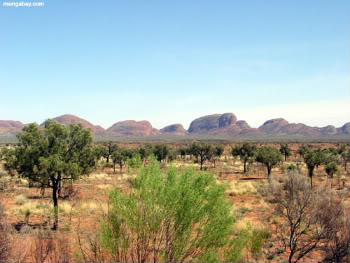 Ayers rock region of Australia. Makarieva and Gorshkov’s theory claimss to explain why the Australian outback is so dry. Photo by Rhett A. Butler. |
This is where Makarieva and Gorshkov’s revolutionary theory fills in the gaps. They posit a ‘pump’, where “areas able to maintain high levels of atmospheric condensation draw in air and moisture from elsewhere”. What regions maintain high levels of atmospheric condensation? Quite simply the answer is forests, with rainforests maintaining greater quantities than temperate, but both are important.
“Forests maintain high evaporation which gets the cycle going,” Sheil told Mongabay.com, ”this can explain how deep wet continental interiors gain high rainfall”.
To explain the ‘pump’ theory in detail, Mongabay.com turned to Makarieva and Gorshkov:
“In any pump (e.g., water pump that pumps water into the swimming pool or your breathing pump [lungs] that pumps air into your body) a drop of fluid pressure is created, so that the fluid streams towards the area with lowered pressure. In the case of biotic pump of atmospheric moisture this drop of air pressure is created by water vapor condensation. That is, pressure of air around us is proportional to the number of gas molecules in a given volume. Condensation of water vapor leads to the disappearance of vapor molecules and results in air pressure drop.” The drop in air pressure is particularly important since it is one of the clear cut observations that “has been routinely overlooked” by conventional meteorologists, according to Murdiyarso and Sheil’s paper.
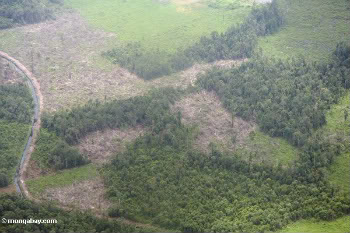 Rainforest slash-and-burned for agriculture in Indonesia could lead to large-scale changes in precipitation near and far. Photo by Rhett A. Butler. |
“Once the pressure gradient is created,” Makarieva and Gorshkov continue, “moist air starts to flow towards the area where condensation is taking place. Water vapor brought with this air sustains the process of condensation and thus sustains the stationary pressure gradient. However, as soon as the incoming air becomes dry (no water vapor), there is nothing to sustain condensation, air pressure tends to equilibrium and the pressure gradient disappears. Thus, for the pump to work, one needs a continuous process of evaporation delivering gaseous moisture to the atmosphere.” No region provides this process of evaporation more effectively than rainforests.
“An actively evaporating natural rainforest will work as a pump continuously supporting lower air pressure above its canopy and thus drawing moist air from the [the ocean]” says Makarieva and Gorshkov. If the rainforest is cutoff or destroyed, water will simply stop being pumped from the ocean and will cease inland, leading to desertification.
But how does this new model, radical in its emphasis, play out against observations of actual weather patterns?
Makarieva and Gorshkov say that their theory “is significant enough to numerically account for the observed wind velocities in all observable circulation patterns, from large scale stationary continental patterns like the Amazon forest pump to spatially and temporarily concentrated patterns like hurricanes and tornadoes”.
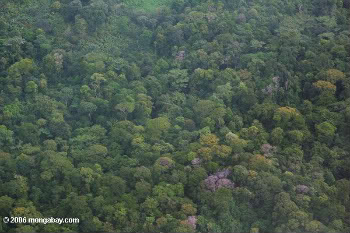 Intact rainforest in Bocas del Toro. Photo by Rhett A. Butler. |
And then comes the statement that has meteorologists rolling in their graves: “this indicates that water vapor condensation is not only a previously unaccounted, but the major, compared to temperature gradients, driver of atmospheric circulation on Earth.”
Meteorology has largely been based on the concept that temperature drives the globe’s wind systems, but the new theory overturns that arguing that oceans and forests, with their ability to produce water vapor condensation, are the real wind movers.
For a specific example Makarieva and Gorshkov point to prehistoric Australia. They believe the pump “explains the enigmatic conversion of Australian forests to deserts that roughly coincides in timing with the appearance of the first people.”
According to Makarieva and Gorshkov, when these early peoples burned small bands of forests along the coast where they first inhabited, “the internal inland forests were cut off from the ocean (the tube of the pump cut off) and underwent rapid desertification.”
Simply put a loss of coastal forests—which had been driving rain from the ocean into the interior—caused Australia’s current dry climate. If Australia hadn’t lost those coastal forests, its environment may be entirely different today—and would not be suffering from extreme and persistent droughts.
Implications: large and comprehensive
The implications of Makarieva and Gorshkov’s explanation of precipitation—and the vital role played by forests—are revolutionary and widespread, which is the reason the theory produces controversy, or is simply dismissed out of hand. Despite this, Makarieva and Gorshkov do not mince words when explaining the importance of their theory and its implications for scientists in all fields:“Biotic forest pump can be considered as the crown of evolution of terrestrial biota, ultimately it was this pump that enabled land to flourish with life.”
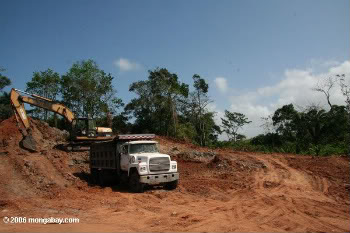 Deforestation of rainforest in Panama. Photo by Rhett A. Butler. |
Regarding forest conservation the impacts are huge, since the pump posits that large tracts of forests actually carry and sustain levels of precipitation. “It should stimulate many stakeholders to see a much greater value in maintaining large forest tracts than they might otherwise,” Sheil says.
And while tropical forests remain the most productive of ecosystems in terms of precipitation, Makarieva and Gorshkov argue that temperate forests are also vital. “This year we have published an extension of precipitation pattern analyses, including more regions for Northern America. From the new data it is evident that the degrading secondary forests of temperate North America are on their way to desertification, losing their ability to transport atmospheric water along the continent.” In a sense this is a contemporary example of what the scientists say occurred in Australia thousands of years ago.
With no end in sight to deforestation, the scientists analyzed the significance of secondary forests cropping up worldwide on the ‘pump’. Makarieva and Gorshkov are skeptical of secondary forests’ ability to keep moisture flowing, attributing much more importance to primary forests.
“All ecological and environmental functions of [secondary] forests, including the pumping abilities, are naturally weakened and destabilized compared to the abilities of the undisturbed primary forests,” they told Mongabay.com “Secondary forests are precious inasmuch as they are allowed to recover towards the primary state.”
However, a slight rift has already appeared regarding secondary forests and their capacity to attract rainfall. In their study Murdiyarso and Sheil argue that secondary forests and even forest plantations “can have desirable evaporation properties.”
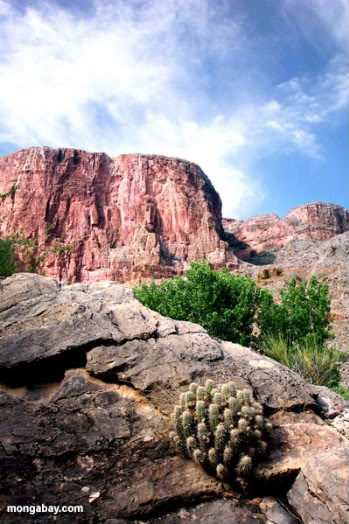 Deer Creek Canyon in Arizona’s Grand Canyon, a mix of desert and dry forest. Photo by Rhett A. Butler. |
Sheil says more, explaining that he believes the relative value of secondary forests “needs to be examined more carefully. I agree that they will likely be less effective but to dismiss their possible value out of hand seems a mistake also. We need more data.”
Murdiyarso and Sheil also argue in their paper that the pump theory actually resurrects a controversial idea: greening deserts. Conventional meteorology makes it impossible that deserts could be greened, i.e. turned into self-sustaining forests with human help, but the new theory changes this. Arguably forests could be planted from coasts leading to interior deserts, bringing rain and reshaping the ecosystem entirely. In effect, it would be the reverse of what happened in prehistoric Australia.
“If forests could be established on a large-scale in deserts (as the new hypothesis implies) they could, if appropriately planned, perhaps bring the rain they need to grow them,” Sheil says. “Once these area were forested the forests would need to be maintained and would capture considerable amounts of carbon (and thus help to reduce the greenhouse effect and limit global warming).”
In fact the implications for global warming are many, including re-evaluation of past ecosystem responses to changes in climate. However on the practical end, the new theory grants a new role for the importance of forests. While they have long been recognized as ‘carbon sinks’ they would now need to be recognized as the ‘bringers of rain’—vital for maintaining a stable and productive climate for every species on earth.
Reaction: from dismissals to comparisons to Copernicus
“We would characterize the first reactions to our findings as mute shock and further neglect, by consequence,” Makarieva and Gorshkov write, noting the difficulties they have encountered not in having their theory accepted—that is a long way off—but simply read and considered.
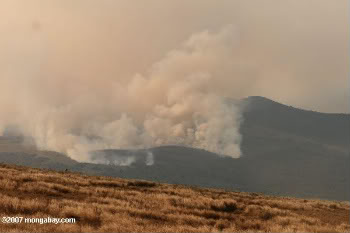 Bush fires in Ngorongoro Crater Conservation Area. Photo by Rhett A. Butler. |
Sheil, who is helping to bring the theory to light says, “I am convinced [the pump theory] deserves very careful scrutiny and not the general dismissal that has happened thus far. It may be wrong in certain aspects but I am sure that the scrutiny will be helpful and productive. This is the nature of science: we don’t need to decide if it is wrong or right but we need to collect the data that will tell us”
While other scientists are being exposed to theory for the first time, Makarieva and Gorshkov argue that it has largely been proven. “The biotic pump theory is derived from fundamental physical principles, it is not a model. We have no doubts that, sooner or later, it will make a revolution in atmospheric physics and environmental science in general. We are facing enormous difficulties in overcoming the initial resistance of the community. We are working further and developing the theory, but we cannot easily publish our new results as people have not yet absorbed and understood what has been already done.”
It may be that so far Makarieva and Gorshkov have been victims of scientific politics. “Indeed,” they write, “as physicists-theoreticians from Russia we do not in the very least belong to the international mainstream meteorological community, and our voices are probably not the ones to be immediately listened to or heard.”
However, Makarieva and Gorshkov do see more and more people becoming aware not only of the theory but its implications: “We are being approached by an increasing number of people, scientists as well as lay members of the society. Unlike meteorologists, the ecohydrologists and paleobotanists are exceptionally interested.”
Most recently, Makarieva and Gorshkov have used their theory to describe tornadoes and hurricanes. It was this study published in the Atmospheric Chemistry and Physics Discussions journal, which “evoked a full spectrum of possible reactions, from ‘not publishable in any serious journal’ to the proposition that our findings are of the same significance to modern meteorology as was Copernicus’ ideas to astronomy”.
While Makarieva and Gorshkov state that they are willing to be patient for their theory to be accepted, they add that “in the case of the biotic pump, time is against the humanity. The water issue is glaring in its importance. The sooner the novel mechanism that we propose is noticed, discussed, verified and recognized by the world scientific community, the sooner the humanity comes into possession of a new tool how to mitigate the on-going degradation of water resources, of a new understanding of how to secure water resources for the future generations.”
While time will surely tell, Makarieva and Gorshkov bring up a good point. Considering rampant deforestation, global warming, desertification, and water security—time is not on our side.
CITATION: Douglas Sheil and Daniel Murdiyarso. 2009. How Forests Attract Rain: An Examination of a New Hypothesis. Bioscience, 59.
Related articles
Amazonian region likely to become savannah due to burning, deforestation
(03/31/2009)
A new analysis shows that the heavily-deforested Amazonian region of Mato Grosso is particularly susceptible to ‘savannization’ due to repeated burning that has likely depleted the region’s soils of precious nutrients. According to the study, published in the Journal of Geophyscial Research, savannization, or the process of tropical ecosystems shifting to savannah, is likely in northern Mato Grosso even if no further deforestation occurs.
Global warming increases “extreme” rain storms
(08/07/2008)
Global warming is increasing the incidence of heavy rainfall at a rate greater than predicted by current climate models have predicted, reports a new study published in the journal Science. The findings suggest that storm damage from precipitation could worsen as greenhouse gas concentrations continue to rise.
NASA study shows global warming will diminish rainfall in East Africa, worsening hunger
(08/06/2008)
A new NASA-backed study has found a link between a warming Indian Ocean and reduced rainfall in eastern and southern Africa. The results suggest that rising sea temperatures could exacerbate food problems in some of the continent’s most famine-prone regions.
75% of world population to face water shortages by 2050
(04/02/2008)
By 2025 more than half of countries will face freshwater stress or shortages and by 2050 as much as 75 percent of the world’s population could face freshwater scarcity, but policy measures and new technologies could help reduce the shortfall, report researchers writing in the journal Nature.
Greenhouse gas emissions have already caused the Amazon to dry
(02/27/2008)
Anthropogenic emissions of greenhouse gases have already caused the Amazon to dry, finds a new study published in Philosophical Transactions of the Royal Society B.
Global warming to hurt agriculture in world’s poorest regions
(01/31/2008)
Global warming wil cause severe crop losses in some of the poorest parts of Africa and Asia by 2030, reports a study published in tomorrow’s issue of the journal Science.
Global warming to cause more severe thunderstorms, reports NASA
(08/31/2007)
Global warming will increase the incidence of severe storms and tornados, report NASA scientists.
Global warming causes increase in tropical rainfall
(08/27/2007)
Climate change appears to be resulting in higher levels of rainfall in the tropics, reports NASA.